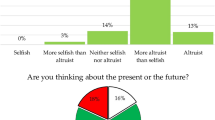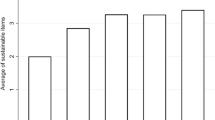Abstract
The primary activities of chemistry involve analysing, synthesizing and transforming matter, yet insufficient attention has been paid to the implications of those activities for human and environmental well-being. Since a core element of addressing sustainability challenges requires attention to the material basis of society, a new paradigm for the practice of chemistry is needed. Chemistry education, especially gateway post-secondary general chemistry courses, should be guided by an understanding of the molecular basis of sustainability. A Systems Thinking in Chemistry Education framework illustrates one way to integrate knowledge about the molecular world with the sustainability of Earth and societal systems.
This is a preview of subscription content, access via your institution
Access options
Access Nature and 54 other Nature Portfolio journals
Get Nature+, our best-value online-access subscription
$29.99 / 30 days
cancel any time
Subscribe to this journal
Receive 12 digital issues and online access to articles
$119.00 per year
only $9.92 per issue
Buy this article
- Purchase on Springer Link
- Instant access to full article PDF
Prices may be subject to local taxes which are calculated during checkout





Similar content being viewed by others
References
Anastas, P. T. & Zimmerman, J. B. The molecular basis of sustainability. Chem 1, 10–12 (2016).
Anastas, P. T. & Zimmerman, J. B. The United Nations Sustainability Goals: How can sustainable chemistry contribute? Curr. Opin. Green. Sustain. Chem. 13, 150–153 (2018).
Stein, L. Y. & Klotz, M. G. The nitrogen cycle. Curr. Biol. 26, R94–R98 (2016).
Erisman, J. W., Sutton, M. A., Galloway, J., Klimont, Z. & Winiwarter, W. How a century of ammonia synthesis changed the world. Nat. Geosci. 1, 636–639 (2008).
Steffen, W. et al. Planetary boundaries: guiding human development on a changing planet. Science 347, 736–747 (2015).
Olivier J. G. J., Janssens-Maenhout, G., Muntean, M. & Peters, J. A. H. W. Trends in Global CO 2 Emissions: 2016 Report PBL publication number: 2315 (PBL Netherlands Environmental Assessment Agency, 2016).
Camilo, M. et al. Broad threat to humanity from cumulative climate hazards intensified by greenhouse gas emissions. Nat. Clim. Change 8, 1062–1071 (2018).
Sjostrom, J. & Talanquer, V. Eco-reflexive chemical thinking and action. Curr. Opin. Green. Sustain. Chem. 13, 16–20 (2018).
Axon, S. & James, D. The UN Sustainable Development Goals: how can sustainable chemistry contribute? A view from the chemical industry. Curr. Opin. Green. Sustain. Chem. 13, 140–145 (2018).
Constable, D. J. C. The practice of chemistry still needs to change. Curr. Opin. Green. Sustain. Chem. 7, 60–62 (2017).
Matlin, S. A., Mehta, G., Hopf, H. & Krief, A. The role of chemistry in inventing a sustainable future. Nat. Chem. 7, 941–943 (2015).
Matlin, S. A., Mehta, G., Hopf, H. & Krief, A. One-world chemistry and systems thinking. Nat. Chem. 8, 393–396 (2016).
Mahaffy, P. G. in Chemistry Education: Best Practices, Innovative Strategies and New Technologies (eds Garcia-Martinez, J. & Serrano, E.) 3−26 (Wiley VCH, 2015).
Luxford, C. J. & Holme, T. A. What do conceptual holes in assessment say about the topics we teach in general chemistry? J. Chem. Educ. 92, 993–1002 (2015).
Reed, J. J., Villafane, S. M., Raker, J. R., Holme, T. A. & Murphy, K. L. What we don't test: what an analysis of unreleased ACS exam items reveals about content coverage in general chemistry assessments. J. Chem. Educ. 94, 418–428 (2017).
Burmeister, M., Rauch, F. & Eilks, I. Education for sustainable development (ESD) and chemistry education. Chem. Educ. Res. Pract. 13, 59–68 (2012).
Holme, T. A. & Hutchison, J. E. A central learning outcome for the central science. J. Chem. Educ. 95, 499–501 (2018).
Wheeler, K. in Education for a Sustainable Future (eds Wheeler, K. A. & Bijur, A. P.) 1–5 (Kluwer, 2000).
de Haan, G. The BLK ‘21’ programme in Germany: a ‘Gestaltungskompetenz’‐based model for education for sustainable development. Env. Educ. Res. 12, 19–32 (2006).
Jegstad, K. M. & Sinnes, A. T. Chemistry teaching for the future: a model for secondary chemistry education for sustainable development. Int. J. Sci. Educ. 37, 655–683 (2015).
Kanapathy, S. et al. Sustainable development concept in the chemistry curriculum. An exploration of foundation students’ perspective. Int. J. Sust. High. Educ. 20, 2–22 (2019).
Bennett, J. & Holman, J. in Chemical Education: Towards Research-Based Practice (eds Gilbert, J. K. et al.) Ch. 8, 165–184 (Science & Technology Education Library, Springer, 2002).
Gilbert, J. K. On the nature of “context” in chemical education. Int. J. Sci. Educ. 28, 957–976 (2006).
Bulte, A. M. W., Westbroek, H. B., de Jong, O. & Pilot, A. A research approach to designing chemistry education using authentic practices as contexts. Int. J. Sci. Educ. 28, 1063–1086 (2006).
Dori, Y. J., Avargil, S., Kohen, Z. & Saar, L. Context-based learning and metacognitive prompts for enhancing scientific text comprehension. Int. J. Sci. Educ. 40, 1198–1220 (2018).
Habig, S. et al. Context characteristics and their effects on students’ situational interest in chemistry. Int. J. Sci. Educ. 40, 1154–1175 (2018).
Mahaffy, P. G., Krief, A., Hopf, H., Mehta, G. & Matlin, S. A. Reorienting chemistry education through systems thinking. Nat. Rev. Chem. 2, 1–3 (2018).
Frank, H. et al. Ethics, chemistry, and education for sustainability. Angew. Chem. Int. Ed. 50, 8482–8490 (2011).
Green Chemistry in the Curriculum (American Chemical Society Committee on Professional Training, 2018).
A Framework for K-12 Science Education: Practices, Crosscutting Concepts, and Core Ideas (National Academies of Sciences, Engineering and Medicine, 2012).
Holme, T. A. & Murphy, K. The ACS Exams Institute undergraduate chemistry anchoring concepts content map I: General Chemistry. J. Chem. Educ. 89, 721–723 (2012).
Holme, T. A., Luxford, C. & Murphy, K. Updating the General Chemistry Anchoring Concepts Content Map. J. Chem. Educ. 92, 1115–1116 (2015).
Springmann, M. et al. Options for keeping the food system within environmental limits. Nature 562, 519–525 (2018).
Boardman, J. & Sauser, B. Systemic Thinking : Building Maps for World Systems (Wiley, 2013).
Jones, C. S. et al. Iowa statewide stream nitrate load calculated using in situ sensor network. J. Am. Water Resour. Assoc. 54, 471–486 (2018).
Galloway, J. N. & Cowling, E. B. Reactive nitrogen and the world: 200 years of change. Ambio 31, 64–71 (2002).
Nørskov, J. & Chen, J. Sustainable Ammonia Synthesis (US Department of Energy, 2016).
Mahaffy, P. G. et al. Beyond “inert” ideas to teaching general chemistry from rich contexts: visualizing the chemistry of climate change (VC3). J. Chem. Educ. 94, 1027–1035 (2017).
Mahaffy, P. G., Brush, E. J., Haack, J. A. & Ho, F. M. Journal of Chemical Education call for papers—special issue on reimagining chemistry education: systems thinking, and green and sustainable chemistry. J. Chem. Educ. 95, 1689–1691 (2018).
Ye, L., Nayak-Luke, R., Banares-Alcantara, R. & Tsang, E. Reaction: “Green” ammonia production. Chem 3, 712–714 (2017).
Fowler, D. et al. The global nitrogen cycle in the twenty-first century. Phil. Trans. R. Soc. B 368, 20130164 (2013).
Smil, V. Detonator of the population explosion. Nature 400, 415 (1999).
Yoho, R. A. & Rittmann, B. E. Climate change and energy technologies in undergraduate introductory science. Environ. Commun. 12, 731–743 (2018).
Pikaar, I. et al. Microbes and the next nitrogen revolution. Environ. Sci. Technol. 51, 7297–7303 (2017).
Acknowledgements
We thank the International Union of Pure and Applied Chemistry (IUPAC Project No. 2017-010-1–050) and the International Organization for Chemical Sciences in Development (Project No. 2017-C4S-ST) for supporting this work, and the two dozen other members of the global IUPAC task force who have contributed to shaping the understanding of Systems Thinking in Chemistry Education.
Author information
Authors and Affiliations
Contributions
P.G.M. and S.A.M. co-chair the IUPAC project on Systems Thinking in Chemistry Education. All authors serve on the steering group for the IUPAC project, on the Earth & Societal Systems Node working group, and contributed to the writing and revision of the paper.
Corresponding author
Ethics declarations
Competing interests
The authors declare no competing interests.
Additional information
Publisher’s note: Springer Nature remains neutral with regard to jurisdictional claims in published maps and institutional affiliations.
Rights and permissions
About this article
Cite this article
Mahaffy, P.G., Matlin, S.A., Holme, T.A. et al. Systems thinking for education about the molecular basis of sustainability. Nat Sustain 2, 362–370 (2019). https://doi.org/10.1038/s41893-019-0285-3
Received:
Accepted:
Published:
Issue Date:
DOI: https://doi.org/10.1038/s41893-019-0285-3
This article is cited by
-
Modern chemistry is rubbish
Nature Reviews Chemistry (2023)
-
Green chemistry as just chemistry
Nature Sustainability (2023)
-
Switching of metal–oxygen hybridization for selective CO2 electrohydrogenation under mild temperature and pressure
Nature Catalysis (2021)
-
Scientific Perspectivism in Secondary-School Chemistry Education
Science & Education (2020)
-
Is Green Chemistry a feasible tool for the implementation of a circular economy?
Environmental Science and Pollution Research (2020)



